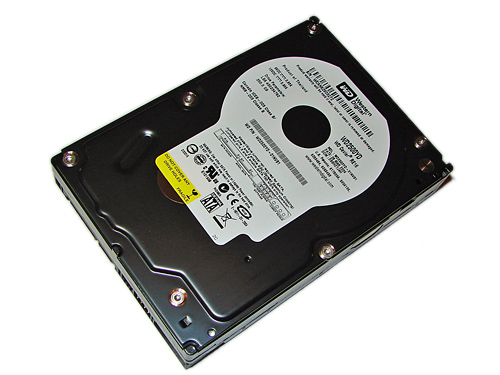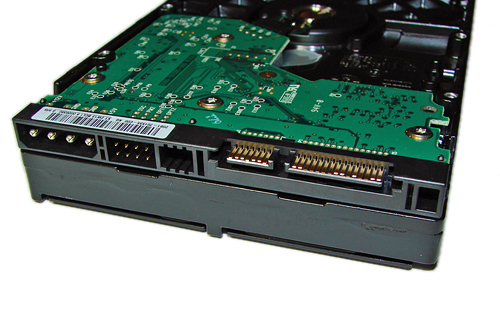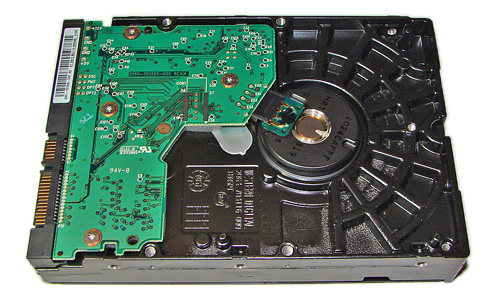Western Digital WD2500YD: Enterprise on the Desktop
by Gary Key on June 24, 2006 10:00 AM EST- Posted in
- Storage
Feature Set

The external design of the Western Digital RE16 series is basically unchanged from the RE2 and Raptor series as it features the now familiar black casing. The drive is based on the industry standard 3.5" form factor platform with pertinent part number and warranty information embossed on a white sticker on the top of the casing.

The RE16 family ships with the Serial ATA data and power connector along with a 4-pin Molex power connector designed for use with older ATX power supplies. To the left of the SATA data and power connectors is an eight-pin jumper block. This jumper block can be utilized to implement spread spectrum clocking or force SATA 1.5Gbs operation. This drive ships with SATA 3Gbs operation enabled. While this feature was advantageous for burst transfer rates in our synthetic benchmarks, overall we did not see any real improvement in our real world benchmarks.

The PCB is openly visible on the bottom of the drive, and as in the previous series the 16 MB of cache memory and controller chips are located on the opposite side of the PCB. All in all, it's a very normal design; it is very difficult to make a hard drive look sexy unless you happen to have a windowed Raptor in your case.
Hardware Setup
We have changed our test beds to reflect changes in the current marketplace. While we wanted to change to the AMD AM2 or Intel Core 2 Duo platform, the product release schedules forced us into staying with a socket 939 based system. Based upon the continuing proliferation of dual core processors and future roadmaps from AMD and Intel signifying the end of the single core processor on the desktop in the near future we have upgraded from our AMD Athlon64 3500+ to an AMD Opteron 170. This change will also allow us to expand our real world multitasking benchmarks in the near future. We will review our test bed requirements once we have an opportunity to thoroughly test the AM2 and Intel Core 2 Duo platforms in the coming weeks.
We debated on the memory size for our iPEAK trace file creations and decided to move to 2GB of system memory. A system with a 1GB memory configuration is the predominant standard at this time in the enthusiast community although 2GB memory setups are becoming more common. While a 1GB memory installation allows us to capture and report a higher amount of disk activity in certain applications, we decided to make the switch at this time as the difference is minimal when compared to the 1GB trace files.

The external design of the Western Digital RE16 series is basically unchanged from the RE2 and Raptor series as it features the now familiar black casing. The drive is based on the industry standard 3.5" form factor platform with pertinent part number and warranty information embossed on a white sticker on the top of the casing.

The RE16 family ships with the Serial ATA data and power connector along with a 4-pin Molex power connector designed for use with older ATX power supplies. To the left of the SATA data and power connectors is an eight-pin jumper block. This jumper block can be utilized to implement spread spectrum clocking or force SATA 1.5Gbs operation. This drive ships with SATA 3Gbs operation enabled. While this feature was advantageous for burst transfer rates in our synthetic benchmarks, overall we did not see any real improvement in our real world benchmarks.

The PCB is openly visible on the bottom of the drive, and as in the previous series the 16 MB of cache memory and controller chips are located on the opposite side of the PCB. All in all, it's a very normal design; it is very difficult to make a hard drive look sexy unless you happen to have a windowed Raptor in your case.
Hardware Setup
| Standard Test Bed Playback of iPEAK Trace Files and Test Application Results |
|
| Processor: | AMD Opteron 170 utilized for all tests. |
| RAM: | 2 x 1GB Corsair 3500LL PRO |
| Settings- DDR400 at (2.5-3-3-7, 1T) | |
| OS Hard Drive: | 1 x Maxtor MaXLine III 7L300S0 300GB 7200 RPM SATA (16MB Buffer) |
| System Platform Drivers: | NVIDIA Platform Driver - 6.85 |
| Video Card: | 1 x Asus 7600GS (PCI Express) for all tests. |
| Video Drivers: | NVIDIA nForce 84.21 WHQL |
| Optical Drive: | BenQ DW1640 |
| Cooling: | Zalman CNPS9500 |
| Power Supply: | OCZ GamexStream 700W |
| Case: | Gigabyte 3D Aurora |
| Operating System(s): | Windows XP Professional SP2 |
| Motherboards: | MSI K8N Diamond Plus |
We have changed our test beds to reflect changes in the current marketplace. While we wanted to change to the AMD AM2 or Intel Core 2 Duo platform, the product release schedules forced us into staying with a socket 939 based system. Based upon the continuing proliferation of dual core processors and future roadmaps from AMD and Intel signifying the end of the single core processor on the desktop in the near future we have upgraded from our AMD Athlon64 3500+ to an AMD Opteron 170. This change will also allow us to expand our real world multitasking benchmarks in the near future. We will review our test bed requirements once we have an opportunity to thoroughly test the AM2 and Intel Core 2 Duo platforms in the coming weeks.
We debated on the memory size for our iPEAK trace file creations and decided to move to 2GB of system memory. A system with a 1GB memory configuration is the predominant standard at this time in the enthusiast community although 2GB memory setups are becoming more common. While a 1GB memory installation allows us to capture and report a higher amount of disk activity in certain applications, we decided to make the switch at this time as the difference is minimal when compared to the 1GB trace files.










11 Comments
View All Comments
driveguy - Monday, June 26, 2006 - link
I do not understand why the YD family was reviewed so late in it's life.The YS familily has been introduced from 160-500GB on a common platform.
It would make much more sense to review the current product.
Gary Key - Monday, June 26, 2006 - link
We reviewed the recent product life update to the YD family that changed it to the RE16 family with 16MB cache and 3GB/s SATA support. The YS family (160GB~320GB range) just started shipping in volume earlier this month and samples are arriving shortly in the 160GB and 250GB sizes. We received the 320GB YS today that will be tested against the other 320GB drives from Western Digital and Seagate in the near future. Thank you for the comments.
driveguy - Tuesday, June 27, 2006 - link
Hi Gary,Thank you for your response.
YS goes from 160GB to 500GB. The real attraction for the RE products is reliability more than performance. This is really not something you can review because you will not have access to field failure rates but these drives have done quite well in high duty cycle envirements. They have crushed STX NL models in the market with the absolute lion's share of this market.
Gary Key - Wednesday, June 28, 2006 - link
Hi,I could have been a little clearer in my 160GB~320GB statement, my point was those drive sizes just started shipping in volume this month. The 400GB and 500GB drives were shipping in May although we have not received the 400GB sample yet. I think with the YS series WD has brought the nearline performance up to and at times exceeding the SE16 line now. I think it will be interesting comparing the NL35.2 to the WD YS series since both are new product releases. We are implementing a 16 drive RAID chassis for enterprise/benchmark testing shortly so we should be able to look at some failure rate information this time next year in this market segment.
Thanks...
Squidward - Monday, June 26, 2006 - link
By looking at this article and others I've seen the Raptor is hands down the best drive you can get without going into SCSI drives. How does that apply to real usage, is the difference that notable versus the other drives in this article? I've been considering buying one if the difference is truly noticable, particularly as it applies to game loading times and recording tv programs.tallman45 - Saturday, June 24, 2006 - link
Nice job as always with the review.A more valuable comparison IMHO though would have been like cost competitors such as the new 74GB 16mb cache Raptor and the 7200.10 320gb Seagate. It stands to reason that a $300 150GB Raptor had better outperform a $90 250gb YD
Gary Key - Saturday, June 24, 2006 - link
Hi,We have the new 74GB 16MB cache Raptor arriving in about 10 days. We have completed our testing on the Seagate 320GB 7200.10 and are in the process of completing several other 200GB~320GB drives for a desktop roundup shortly in what we believe is the best price to performance range at this time. Our 500GB roundup and PVR article will be available in late July. As stated in the article we will also do a separate review on RAID performance with both nearline enterprise and desktop drives in the near future. The process of adding additional multi-tasking benchmarks along with doing both hardware (Areca) RAID and soft (nF500) RAID is painstakingly slow. ;->
The other process we have setup is an additional test bench that is currently running previously reviewed drives 24/7 with varying stress tests so we can start reporting on reliability and doing a quick follow-up on the drives performance every few months. In about two weeks, you should start seeing storage articles from us about every 10 days.
Thank you for the comments.
Gary Key - Saturday, June 24, 2006 - link
Where is the edit button? :) I meant to end my reply with "storage reviews from us about every 10 days or less."dhei - Saturday, June 24, 2006 - link
150gig raptor is around $200 now...dhei - Saturday, June 24, 2006 - link
forgot to add the 75gig Raptor is only $130. In terms of pure performance most people would go for the little premium in price for Raptor than more hd space. They just get a 200+gig drive for backup and install main apps on raptor.